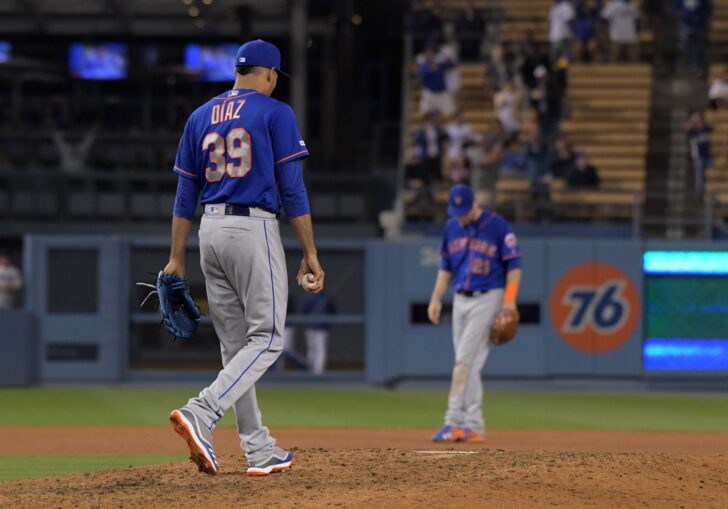
Without a doubt, the Mets’ blockbuster trade for Robinson Cano and Edwin Diaz looked risky at the time of the deal, and looks even worse now at the midpoint of the 2019 season.
While giving away Jarred Kelenic and Justin Dunn was a tough pill to swallow, and taking on Cano’s contract was a risky commitment, there was at least one silver lining in the trade that was supposed to be a given: The Mets were gaining a young, elite closer with five years of team control. Regardless of the exterior negative side effects of the trade in the long run, the Mets could find comfort in knowing that they at least gained one valuable asset.
Coming off a historic season with Seattle in which Diaz posted a 1.96 ERA, 1.61 FIP, saved 57 games, and won the AL Reliever of the Year Award, the expectations were certainly high for the 25-year-old fireballer as he joined a team with serious playoff aspirations. However, as part of a dumpster fire Mets bullpen, which has posted the highest ERA so far in franchise history, Diaz has been arguably the biggest disappointment.
Diaz’s Mets tenure started off great, as through April 28 he looked just like the guy the Mets thought they had traded for. He owned a 0.84 ERA with an absurd 16.9 K/9 and 1.7 BB/9, giving him a 1.23 FIP. For the first month of the season, Diaz was utterly dominant, picking up right where he had left off with the Mariners.
For most of May, Diaz kept it up, as he still held a 1.64 ERA on May 28. However, the walks and hits were starting to pile up, and the Dodgers finally made him pay in a four-run meltdown at Dodger Stadium on May 29.
Unfortunately, it’s only gone further downhill for Diaz since then. While he has still shown signs of dominance here and there, his outings have been inconsistent, and at times, teams have been hitting him really hard. After so much hype on this guy and with Brodie Van Wagenen going all-in just to acquire him, Diaz severely disappointed, ending the first half with an ugly 5.50 ERA.

So what exactly went wrong, especially after such a promising start?
First of all, Diaz’s signature slider that was a huge key in his 2018 success has been hit hard this year. Last year, opposing hitters’ wOBA against the pitch was a stellar .190, while this year that number has jumped up to .354. He’s also not getting as many swings and misses with the pitch, as his slider whiff percent has dropped from 53.8 to just 39.8.
While to a lesser extent, the numbers are also worse against Diaz’s 97 mph four-seam fastball. In 2018, he allowed a .238 wOBA against the pitch, while this year he’s allowing a mark of .335.
Clearly, something has not been quite right with Diaz, and it’s been evident in his unusual number of collapses this first half. In general, he’s been getting hit much harder, with his barrel percent jumping from 3.8 to 6.0 and his average exit velocity climbing from 87.8 to 90. His hard-hit percent has also gone from 35.3 to an ugly 44.4. So teams area barreling the ball more often against Diaz and hitting it hard.
While these numbers are obviously not encouraging, there is some hope. Diaz’s velocity is still there, as his fastball is sitting at 97 mph and being complemented with an 89 mph slider, just like last year. The main difference that is hurting him is location.
As you can in see the graphs, found on Baseball Savant courtesy of MMO‘s Mathew Brownstein, Diaz is leaving specifically his slider in the middle of the plate more often. So while he’s still throwing it hard, he’s just missing his location with it, which is an easier fix than if he had lost a notable amount of velocity.
Heatmaps for Edwin Diaz's slider from '19 (left) to '18 (right).
Appears to be leaving his slider in the middle of the zone a lot more.
Could be why his slider's avg. exit velo has risen nearly 4.0 mph, launch angle increased 9 degrees & his xwOBA has gone up 93 points. #Mets pic.twitter.com/XStqiqk3S0
— Mathew Brownstein (@MBrownstein89) July 6, 2019
While Diaz’s slider is getting hit harder largely because of his command issues, there is some evidence that he may be experiencing some bad luck on batted balls. For starters, his BABIP is a ridiculous .421, which is unsustainable even for the worst pitchers, let alone a pitcher with stuff as good as Diaz’s. For reference, last year his BABIP was .281, and his career BABIP is .313.
The increase in hard-hit percentage is definitely a factor in this startling jump, but it’s not all Diaz’s fault. His xwOBA on his slider is .261, much lower than the actual wOBA of .354. While that’s not quite the phenomenal .168 xwOBA he posted last year with his slider, it’s still very good and shows that Diaz has been getting unlucky on batted balls, to an extent.

The xwOBA on his fastball is even more encouraging, with his .260 mark being nearly identical to last year’s mark of .259. The gap in the actual wOBA allowed is much larger though, which as previously mentioned has gone from .238 to .335.
Plus, Diaz is still recording strikeouts and limiting walks at an elite level. He has a spectacular 14.68 K/9, which is a credit to just how good his stuff is. Even when he’s a little off and missing location, his stuff is still good enough to mow down opposing batters. And while the walks have been a bit up recently, he still has a very good 2.88 BB/9 on the season.
Really the only peripheral stat that’s a bit more concerning is his HR/9, which is a rough 1.83. This number can be credited to the increase in exit velocity on his batted balls, as well as the home run rampage going on around baseball. His HR/FB percent has rocketed from 10.6 to 21.9 though, so his home run numbers should come back to Earth in the second half.
Overall, Diaz’s first impressions as a Met have been disappointing, but there is plenty of reason to be optimistic about him going forward. Remember, the Mets still have this guy for four and a half more years. He was bound to regress anyway after his fantastic season for the Mariners last year, so this could very well just be regression to the mean in full effect.
He hasn’t been pitching with the same excellent command that brought him so much success last year, but his dominant stuff is still there, and that combined with a fair share of bad luck has inflated his numbers to a much lower point than his true talent level.
Yes, the trade is still looking like a disaster for a multitude of reasons, but Mets fans should still be excited about what Diaz can bring to this team through the remainder of this season and in the upcoming four seasons.















